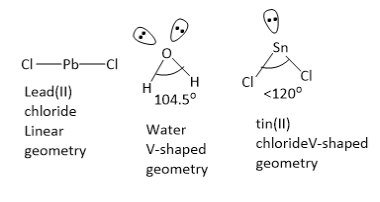
Which molecule has V-shape? This question has multiple correct options
(A) \[{{\text{H}}_{\text{2}}}{\text{O}}\]
(B) \[{\text{SnC}}{{\text{l}}_{\text{2}}}\]
(C) \[{\text{PbC}}{{\text{1}}_{\text{2}}}\]
(D) None of these
Answer
554.4k+ views
Hint: In each molecule, determine the hybridization of the central atom. From the hybridization, determine the electron pair geometry and the molecular geometry.
Complete step-by-step answer:
\[{\text{PbC}}{{\text{1}}_{\text{2}}}\] molecule has linear geometry. In water molecules, the central oxygen atom has 2 bond pairs and 2 lone pairs of electrons. Oxygen atom is \[{\text{s}}{{\text{p}}^3}\] hybridized with tetrahedral electron pair geometry and V shaped molecular geometry. The ideal tetrahedral bond angle is \[{\text{10}}{{\text{9}}^o}{\text{28'}}\] , but in water molecule, the \[{\text{H}} - {\text{O}} - {\text{H}}\] bond angle is \[{\text{104}}{\text{.}}{{\text{5}}^o}\] . This is due to greater lone pair lone pair repulsion and lone pair bond pair repulsion as compared to bond pair bond pair repulsion.
In \[{\text{SnC}}{{\text{l}}_{\text{2}}}\] molecule, the central tin atom has 2 bond pairs and 1 lone pair of electrons. Tin atom is \[{\text{s}}{{\text{p}}^2}\] hybridized with Trigonal planar electron pair geometry and V shaped molecular geometry. The ideal bond angle is \[{\text{12}}{{\text{0}}^o}\] , but in \[{\text{SnC}}{{\text{l}}_{\text{2}}}\] molecule, the \[{\text{Cl}} - {\text{Sn}} - {\text{Cl}}\] bond angle is less \[{\text{12}}{{\text{0}}^o}\] . This is due to greater lone pair bond pair repulsion as compared to bond pair bond pair repulsion. The molecules \[{{\text{H}}_{\text{2}}}{\text{O}}\]and \[{\text{SnC}}{{\text{l}}_{\text{2}}}\] have V-shaped geometries.
Hence, the options (A) and (B) are the correct answers.

Note: For several molecules, the electron pair geometry is different from the molecular geometry. This is due to the presence of lone pairs of electrons on the central atom.
Complete step-by-step answer:
\[{\text{PbC}}{{\text{1}}_{\text{2}}}\] molecule has linear geometry. In water molecules, the central oxygen atom has 2 bond pairs and 2 lone pairs of electrons. Oxygen atom is \[{\text{s}}{{\text{p}}^3}\] hybridized with tetrahedral electron pair geometry and V shaped molecular geometry. The ideal tetrahedral bond angle is \[{\text{10}}{{\text{9}}^o}{\text{28'}}\] , but in water molecule, the \[{\text{H}} - {\text{O}} - {\text{H}}\] bond angle is \[{\text{104}}{\text{.}}{{\text{5}}^o}\] . This is due to greater lone pair lone pair repulsion and lone pair bond pair repulsion as compared to bond pair bond pair repulsion.
In \[{\text{SnC}}{{\text{l}}_{\text{2}}}\] molecule, the central tin atom has 2 bond pairs and 1 lone pair of electrons. Tin atom is \[{\text{s}}{{\text{p}}^2}\] hybridized with Trigonal planar electron pair geometry and V shaped molecular geometry. The ideal bond angle is \[{\text{12}}{{\text{0}}^o}\] , but in \[{\text{SnC}}{{\text{l}}_{\text{2}}}\] molecule, the \[{\text{Cl}} - {\text{Sn}} - {\text{Cl}}\] bond angle is less \[{\text{12}}{{\text{0}}^o}\] . This is due to greater lone pair bond pair repulsion as compared to bond pair bond pair repulsion. The molecules \[{{\text{H}}_{\text{2}}}{\text{O}}\]and \[{\text{SnC}}{{\text{l}}_{\text{2}}}\] have V-shaped geometries.
Hence, the options (A) and (B) are the correct answers.

Note: For several molecules, the electron pair geometry is different from the molecular geometry. This is due to the presence of lone pairs of electrons on the central atom.
Recently Updated Pages
Why are manures considered better than fertilizers class 11 biology CBSE

Find the coordinates of the midpoint of the line segment class 11 maths CBSE

Distinguish between static friction limiting friction class 11 physics CBSE

The Chairman of the constituent Assembly was A Jawaharlal class 11 social science CBSE

The first National Commission on Labour NCL submitted class 11 social science CBSE

Number of all subshell of n + l 7 is A 4 B 5 C 6 D class 11 chemistry CBSE

Trending doubts
10 examples of friction in our daily life

One Metric ton is equal to kg A 10000 B 1000 C 100 class 11 physics CBSE

Difference Between Prokaryotic Cells and Eukaryotic Cells

1 Quintal is equal to a 110 kg b 10 kg c 100kg d 1000 class 11 physics CBSE

State the laws of reflection of light

Explain zero factorial class 11 maths CBSE




